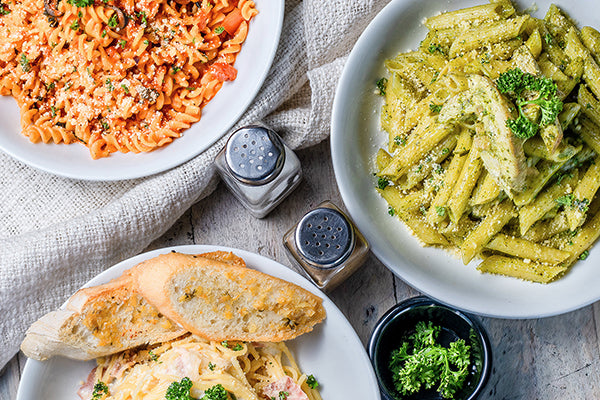The anti-dry pasta movement has reached a critical mass.
Food blogs are populated with praise for the latest, handmade pasta specialist who travelled back to Italy to learn from the masters. Cooking channel reruns push homecooks to make fresh pasta from scratch. Even the highest quality, store-bought pasta has been demoted to forgotten corners of grocery aisles.
When did the food world declare fresh pasta superior to dried?
Maybe it’s our national predilection to declare a winner for everything? A misappropriation of the truism—fresh is better? Misplaced hate for anything from a bag?
Come on people! The pasta on pasta crime must stop. Apologies to those with fresh pasta loyalties, but we are here to plant our flag in the sand and say: dried pasta is just as good—and sometimes better—than fresh pasta. We take our lead from the motherland, and Italy is clear on the debate.
The Italians know that pasta is a vehicle for flavor. Sauce determines the style of pasta.

Difference between Dry Pasta and Fresh Pasta
Dried pasta (pasta secca) and fresh pasta (pasta fresca) are two completely different types of pasta. Despite what you might think, dried pasta is not fresh pasta that has been left to dry. Each pasta is made with different ingredients and different techniques.
The main difference between the two? The ingredients. Fresh pasta is made with flour and egg. Dried pasta is made with durum wheat and water. One is made by hand, the other is made by custom-designed machines.
These small differences create unique textures, flavors, and colors. It also means that many of our favorite pasta shapes can only be achieved with dried pasta.

When to Use Dry Pasta Versus Fresh Pasta
Look no further than the concept of al dente. Translated as “to the tooth,” al dente refers to the perfect level of pasta doneness. Dry pasta can be cooked al dente, while fresh pasta starts and stays tender.
Dry pasta has the structural integrity to withstand recipes that require vigorous stirring such as a cacio e pepe. Such strong stirring would break the delicate strands of fresh pasta. Dry pasta also does better in dishes with large components such as broccoli or sausage. Fresh pasta tends to clump, resulting in uneven mixing of the different parts.
Flavor also plays a big role and as we mentioned before, pasta is a vessel for the sauce. This means you want to match the type of sauce with the type of pasta.
As a general rule of thumb, fresh pasta is better with butter or cream-based sauces and fillings. The delicate flavors blend well with the texture of the pasta. A soft and subtle bite marries perfectly with the creamy flavors. On the other hand, dried pasta stands up better for heavier sauces, especially meat sauces.
While the pasta debate rages on, there’s one thing both sides can agree on. Quality, technique, and tradition matters.

Where to Buy Dry Pasta
When it comes to dry pasta, there’s one name to know—Mancini. This family-run producer is bringing back the old tradition of vertical integration. They handle every step of the process in house, from growing and harvesting the wheat, to milling and forming of the pasta.
Mancini cultivates a variety of durum wheat strains on a range of terroirs in La Mache. Each variety of wheat ripens at a different pace with different yields, gluten structure, and protein levels. Mancini’s pasta is a careful blend of the different estate-grown wheat types. The blending of the wheats creates incredible complexity in the pasta.
The milled wheat is mixed with water and extruded through custom, bronze dies. The bronze is important. It increases both the porousness and roughness of the pasta’s surface. This unlocks the perfect marriage of dry pasta and sauce. Did we mention the importance of sauce and pasta?
It’s a flavor and texture that you have to try to truly understand. Lucky for you, we carry the full line of Mancini Pasta.


